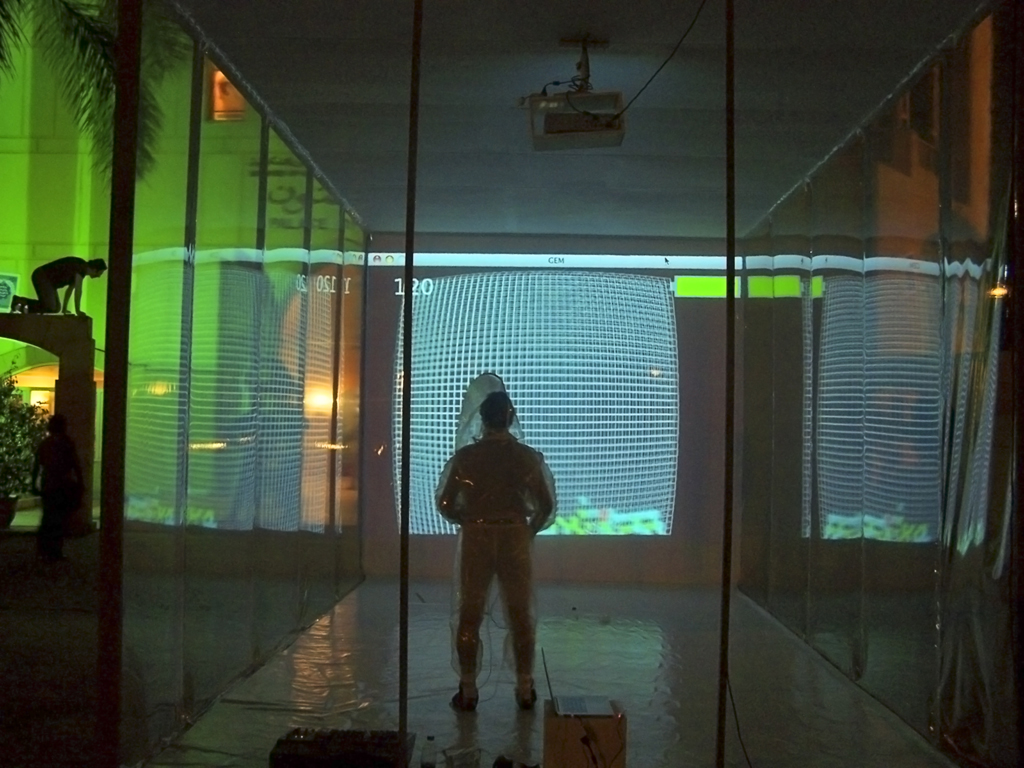 Ahmed Basiony‘s 30 Days of Running in Place was first presented at the Why Not exhibition in Cairo in 2010. Basiony performed daily for 30 days in a room enclosed in transparent plastic outside the Cairo Opera House and Palace of Arts – The artist jogged around the room wearing a plastic suit fitted with digital sensors that gathered and wirelessly transmitted data on his movements and physiological parameters – This information was in turn processed and projected on a large screen as an ever-changing visual and aesthetic reflection of the artist’s physical state.
Ahmed Basiony‘s 30 Days of Running in Place was first presented at the Why Not exhibition in Cairo in 2010. Basiony performed daily for 30 days in a room enclosed in transparent plastic outside the Cairo Opera House and Palace of Arts – The artist jogged around the room wearing a plastic suit fitted with digital sensors that gathered and wirelessly transmitted data on his movements and physiological parameters – This information was in turn processed and projected on a large screen as an ever-changing visual and aesthetic reflection of the artist’s physical state.
The work was shown again posthumously as a five-channel installation in Egyptian Pavilion at the Venice Biennale 2011. Here, 30 Days was juxtaposed with videos recorded by Basiony during his participation in the January revolution, until he was killed by gunshot wounds inflicted by Egyptian Police snipers on January 28, 2011. The videos intermingled, creating a poignant counterpoint between aristic performance and political action.
According to Egyptian Pavilion curator Aida Eltorei, the project “marks a specific time when the artist ran in place in anticipation of countering [and recording] a digital reaction; the aim was to observe how through the act of running in place – with sensors installed in the soles of his shoes and on his body [to read levels of body heat] – a visual diagram of codes could be extracted, and to visually witness the movement of energy and physical consumption be born in an image.”2
Eltorei underlined that the choice of Basiony for this year’s Venice Biennale was not motivated by the fact that he is a martyr of the January 25 Revolution. “The Biennale honours artists who create something new in the contemporary fine arts field; artists who have original artistic propositions and sustain activity in their visions and projects,” Eltorei asserted.2
Pavilion executive curator Shady El Noshokaty considers 30 Days “one of the greatest creative concepts presented by Basiony – by him and about him – during the last period of his life. It certainly marks its significance as a critically acclaimed work, and the first of its kind in new media arts in the Middle East.”2
1. http://artculture.com/contemporary-art/venice-biennale-2011/ahmed-basiony-egyptian-art
2. http://english.ahram.org.eg/NewsContent/5/25/13655/Arts–Culture/Visual-Art/Venice-Biennale-exhibits-Egyptian-artist,-Ahmed-Ba.aspx
See also http://www.ahmedbasiony.com/
Artist’s biography: http://artelectronicmedia.com/biography/ahmed-basiony-biography
